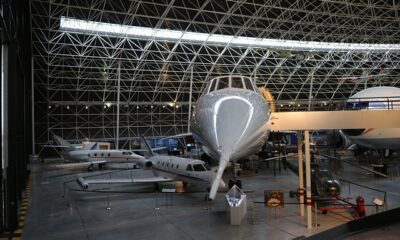Aerospace
10 things about Bell 360 invictus helicopter

1. Manufacture and Development of The Bell 360 Invictus Helicopter
The Bell 360 Invictus helicopter is manufactured by Bell Textron which is origins from United States. And its primary role is Future Attack Reconnaissance Aircraft (FARA). The first flight is scheduled for 2023.The Bell 360 Invictus is revolutionizing attack reconnaissance capabilities to advance the role of the ground maneuver commander and carry out the Future Attack Reconnaissance Aircraft (FARA) initiative of the United States Army. The aircraft uses a shared open architecture digital backbone similar to the Bell V-280 Valor to give the US Army an always-ready advantage with an unbeatable fleet.
2. Features of the Bell 360 Invictus
Maneuverability : The Bell 360 Invictus’ design offers superior speed, range, and agility regardless of the terrain, be it rough rural terrain or urban canyons. Versatility for attack and reconnaissance operations in any environment is made possible by the strong, articulated rotor, lift-sharing wing, and improved tail rotor.
3. Lethality
The Bell 360 Invictus, which carries a 20mm cannon and an internal payload with a modular effects launcher to handle both current and future ordnance, is always ready to finish the war. Situational awareness is raised and lethality is increased across a wide range of multi-domain applications unique combination of modern sensors and air-launched effects.
4. Sustainability
Scouts need consistently show up. It is necessary for the maneuvering force. When a soldier looks upward, the Bell 360 Invictus will be over their shoulder and in the battle to an emphasis on contemporary production techniques and methods that boost acquisition affordability and optimise reliability.
5. Supplement power unit
Performance and safety are combined via innovation with the integrated supplemental power unit (SPU). It serves two purposes and it delivers more horsepower to increase cruise airspeed, dash speed, hover payload, and authoritative performance. The extra horsepower is used for ground maintenance and system checks.
6. Fly by Wire system
Bell’s innovative digital flight control system, which has been tested on the Bell V-280 Valor and Bell 525 Relentless, integrates established technology for next-generation performance while providing a route for upgrading to higher-level capabilities, like optimally crewed flight operations. The system supports Level 1 handling qualities and has triplex redundancy, giving tactical teams the avionics and mobility they need to complete missions successfully.
7. Digital Thread
All aspects of design, supply chain, and maintenance are connected by our specialised tools built on the digital thread. This digital toolbox enables real-time cooperation, which lowers downstream costs and saves hundreds of man hours by supporting smoother manufacturing, better sustainability, and fewer schedule hazards.
8.Bell 360 Invictus cockpit
The Bell 360 Invictus has a tandem cockpit and a single main rotor, and it can travel at least 180 mph. The aircraft’s main rotor system is based on Bell’s 525 Relentless helicopter which has flown at speeds beyond 200 knots in test flights but will be scaled to fit the Invictus. While the Bell 525 has five rotor blades, the 360 Invictus will have four.
9. Specifications of Bell 360 Invictus Helicopter
Bell’s 360 Invictus has a 210 mph (330 km/h, 180 kn) cruise speed and a cargo capability of up to 1,400 lb with two crew members. Its main engine will be a single General Electric T901 turboshaft engine, with supplemental power from a Pratt & Whitney PW207D1 turboshaft.

Aerospace
When Ratan Tata was denied entry to the airfield at the Aero India show, he waited

During our visit to Aero India 2019, we had the unexpected opportunity to see Ratan Tata at the event, which was a thrilling moment for us. However, there was a surprising hiccup when the security staff didn’t allow him to enter due to a lack of a security pass.
Despite this, he remained calm and patiently waited for about 20 minutes until a member of the Tata team brought him the required pass, after which he calmly proceeded inside. It was a humbling sight, showcasing his composed demeanor even in such situations.
Ratan Tata ji is not only a renowned industrialist but also a trained pilot, holding a pilot’s license. In 2007, he became the first Indian civilian to fly the F-16 Falcon during the Aero India show in Bangalore—a proud moment for the nation.
His passion for aviation extended beyond flying, as he played a key role in shaping India’s aerospace industry. Under his leadership, Tata ventured into manufacturing and maintaining aerospace components while upholding its legacy of quality. Notably, Tata’s collaboration with Airbus to develop and manufacture the C295 aircraft is a testament to its growing influence in the sector.
-

 Aviation2 months ago
Aviation2 months agoBoeing confirms 797: A New Era for Mid-Size Aircraft
-

 Aviation1 month ago
Aviation1 month agoMicrosoft Flight Simulator Raises $3 Million to Bring Back the An-225 Mriya
-

 Aviation2 months ago
Aviation2 months agoLockheed and Tata Team Up to Build C-130J MRO Facility in India
-

 Tech2 months ago
Tech2 months agoChina Developing Jet to Travel Anywhere in Two Hours
-

 Airlines2 months ago
Airlines2 months agoQantas Engineers Stage Walkout Over Cost of Living Concerns
-

 Airlines1 month ago
Airlines1 month agoQatar Citizens Can Travel to the United States Without a Visa
-

 Aviation2 months ago
Aviation2 months agoBoeing Offers 25% Pay Increase & Promise to Build Next Plane in Seattle
-

 Airlines2 months ago
Airlines2 months agoIndian Government Approves Air India and Vistara Merger








